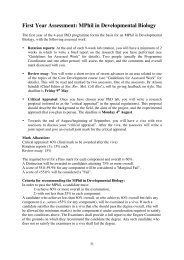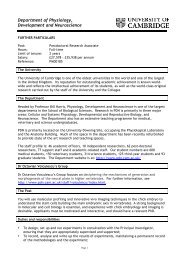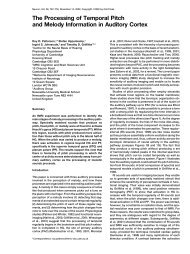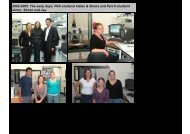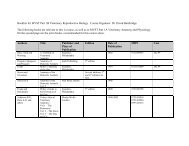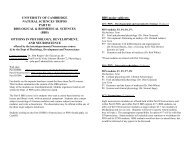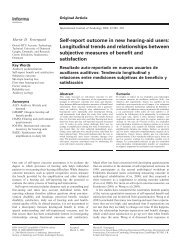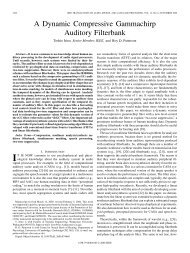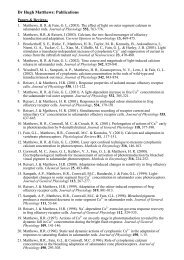part ii physiology, development and neuroscience - Department of ...
part ii physiology, development and neuroscience - Department of ...
part ii physiology, development and neuroscience - Department of ...
Create successful ePaper yourself
Turn your PDF publications into a flip-book with our unique Google optimized e-Paper software.
The module is based on lecture series covering the oculomotor system, cerebellum, motor cortex, basal<br />
ganglia, <strong>and</strong> long latency reflex actions. A practical class on oculomotor control is associated with the<br />
module.<br />
This module cannot be taken with Development: Patterning the Embryo (P4).<br />
Module organiser: Dr Steve Edgley (sae1000@cam.ac.uk)<br />
Module N4: Sensory Transduction (N)<br />
The process <strong>of</strong> transduction within individual sensory receptors has consequences for, <strong>and</strong> imposes<br />
limits on, the perception <strong>of</strong> sensory events. Considerable advances have been made in recent years in<br />
elucidating the means by which primary sensory stimuli are transduced <strong>and</strong> processed. The module<br />
begins by examining the molecular mechanisms which enable vertebrate photoreceptors to respond with<br />
incredible sensitivity to individual photons <strong>of</strong> light, yet which also allow the cells to recover rapidly <strong>and</strong> to<br />
respond effectively at high light intensities. This will be followed by consideration <strong>of</strong> invertebrate<br />
phototransduction, which will include the ever-more-widespread roles <strong>of</strong> TRP channels which were<br />
originally discovered in this system. The modality then shifts to the chemical senses, to discuss<br />
transduction <strong>and</strong> coding in olfactory receptors, which share some fascinating features in common with<br />
phototransduction, as well as exhibiting some marked differences. Coverage <strong>of</strong> mechanotransduction<br />
ranges from the incredibly sensitive mechanisms by which the hair cells in the vertebrate ear respond to<br />
sound, <strong>and</strong> the analogous processes in insects, to the properties <strong>of</strong> muscle spindles which subserve<br />
both reflex responses <strong>and</strong> conscious proprioception. These special senses will be contrasted with the<br />
molecular <strong>and</strong> cellular mechanisms responsible for the transduction <strong>of</strong> pain.<br />
You are also likely to find the module on Central Mechanisms <strong>of</strong> Sensation & Behaviour (N6) interesting<br />
<strong>and</strong> relevant.<br />
This module cannot be taken with Fetal <strong>and</strong> Placental Physiology (P3)<br />
Module organiser: Dr Hugh Matthews (hrm1@cam.ac.uk)<br />
Module P1: Cellular Physiology (P)<br />
Cells detect <strong>and</strong> respond to changes in their external environment through a cornucopia <strong>of</strong> signalling<br />
pathways. Many <strong>of</strong> the pathways involve complex biochemical reactions, but some are more amenable<br />
to study by the physiologist – in <strong>part</strong>icular membrane potential, calcium <strong>and</strong> pH. Thus, in this module we<br />
look at cellular signalling from a Physiological viewpoint rather than 'stamp collecting' all <strong>of</strong> the signalling<br />
pathways. The three main signalling mechanisms we have selected here are used by both excitable <strong>and</strong><br />
in-excitable cells to transmit information from the cell surface to effector systems. We start the module<br />
by looking at the basic ionic regulation mechanisms that allow signalling to exist. We then move to<br />
looking at the ion channels that allow calcium into cells. This is followed by a series <strong>of</strong> lectures on<br />
intracellular calcium signalling. The calcium signals also result in pH microdomains, which are also<br />
potential signals. We then focus on the membrane, <strong>and</strong> consider how lig<strong>and</strong>s can result in potential<br />
changes <strong>and</strong> how these potential changes can be modified by signalling pathways. We end the series <strong>of</strong><br />
lectures by bringing together membrane potential changes <strong>and</strong> calcium signalling with lectures on<br />
skeletal muscle <strong>and</strong> meta plasticity. The module contains a series <strong>of</strong> workshop/seminars on<br />
mathematical modelling, molecular techniques, drosophila as a model organism, fluorescence<br />
measurements <strong>and</strong> microelectrode techniques.<br />
This module cannot be taken with Molecular <strong>and</strong> Cellular Pharmacology (N2) or Development:<br />
Patterning the Embryo (P4).<br />
Module organiser: Dr Christ<strong>of</strong> Schwiening (cjs30@cam.ac.uk)<br />
10



